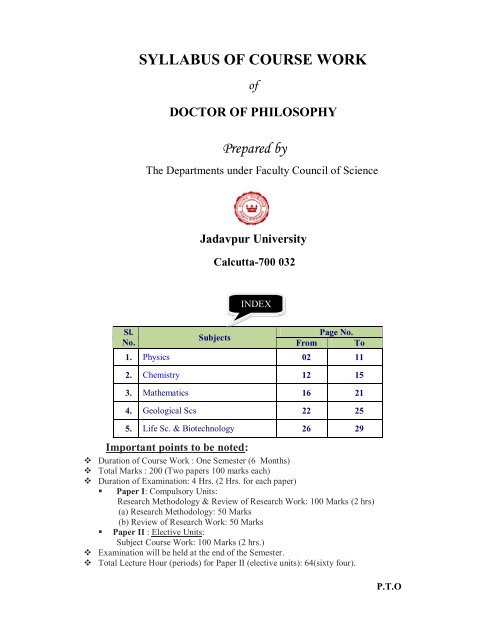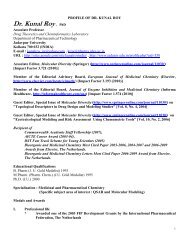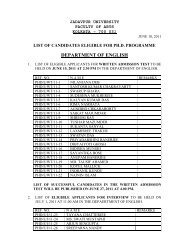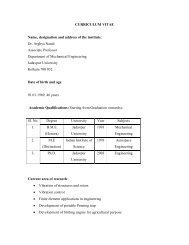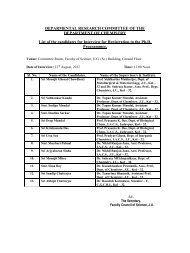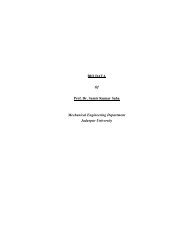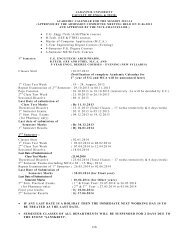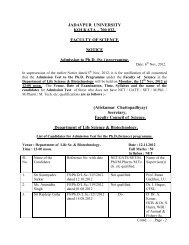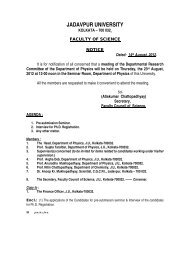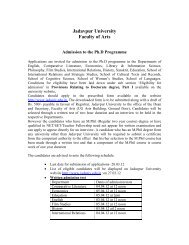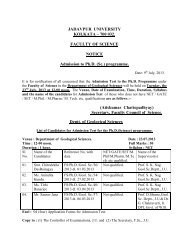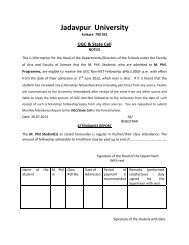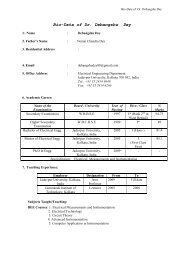SYLLABUS OF COURSE WORK Prepared by - Jadavpur University
SYLLABUS OF COURSE WORK Prepared by - Jadavpur University
SYLLABUS OF COURSE WORK Prepared by - Jadavpur University
You also want an ePaper? Increase the reach of your titles
YUMPU automatically turns print PDFs into web optimized ePapers that Google loves.
<strong>SYLLABUS</strong> <strong>OF</strong> <strong>COURSE</strong> <strong>WORK</strong><br />
of<br />
DOCTOR <strong>OF</strong> PHILOSOPHY<br />
<strong>Prepared</strong> <strong>by</strong><br />
The Departments under Faculty Council of Science<br />
<strong>Jadavpur</strong> <strong>University</strong><br />
Calcutta-700 032<br />
INDEX<br />
Sl.<br />
No.<br />
Subjects<br />
Page No.<br />
From To<br />
1. Physics 02 11<br />
2. Chemistry 12 15<br />
3. Mathematics 16 21<br />
4. Geological Scs 22 25<br />
5. Life Sc. & Biotechnology 26 29<br />
Important points to be noted:<br />
Duration of Course Work : One Semester (6 Months)<br />
Total Marks : 200 (Two papers 100 marks each)<br />
Duration of Examination: 4 Hrs. (2 Hrs. for each paper)<br />
• Paper I: Compulsory Units:<br />
Research Methodology & Review of Research Work: 100 Marks (2 hrs)<br />
(a) Research Methodology: 50 Marks<br />
(b) Review of Research Work: 50 Marks<br />
• Paper II : Elective Units:<br />
Subject Course Work: 100 Marks (2 hrs.)<br />
Examination will be held at the end of the Semester.<br />
Total Lecture Hour (periods) for Paper II (elective units): 64(sixty four).<br />
P.T.O
<strong>SYLLABUS</strong> <strong>OF</strong> <strong>COURSE</strong> <strong>WORK</strong> <strong>OF</strong> PH.D(Sc.)<br />
DEPARTMENT <strong>OF</strong> PHYSICS<br />
Courses Subject Full Marks<br />
Compulsory<br />
Units<br />
1. Research Methodology 50<br />
2. Review of Research Work 50<br />
1. Material Characterization Techniques. 50<br />
2. Production of low temperatures and low-temperature<br />
properties of materials.<br />
3. Physics of semiconductor structures and quantum well<br />
devices.<br />
4. Dynamical Systems. 50<br />
50<br />
50<br />
5. Critical phenomena and renormalization group. 50<br />
6. Non-equilibrium statistical mechanics and surface growth. 50<br />
Elective Units<br />
7. Relativistic heavy ion Physics. 50<br />
8. Environmental Radiation and Health Physics Fundamentals. 50<br />
9. Advanced X-ray crystallography. 50<br />
10. Biophysics. 50<br />
11. Physical Cosmology. 50<br />
12. Monte Carlo methods in statistical physics. 50<br />
13. General Relativity. 50<br />
N.B. : Students to opt for any 2 elective units out of the elective units offered. 32x2 classes to<br />
be attended (100 marks) - 4 classes to be held every Saturday evening.<br />
2 | P a g e
compulsory units<br />
1. Research Methodology (40 lectures)<br />
Definition of the Problem: Identifying and formulating the problem.<br />
Techniques involved in solving the problem:<br />
a) Exact analytical solution of equations involved.<br />
b) Numerically solving equations.<br />
c) Simulating the problem on a computer. Monte Carlo or molecular dynamics approach.<br />
d) Experimental observations and theoretical modeling<br />
Developing a research plan: Research objective: information required for solving the<br />
problem: defining each major concept in operational terms: an overall description of<br />
approach, clearly stating any assumptions; details of techniques.<br />
Methods of data collection: Experimental data, field data, data from other sources.<br />
Analyzing data: Error analysis, statistical analysis<br />
Using computers in research:<br />
Basics of operating systems – handling different operating systems<br />
1. Literature survey using web, handling search engines<br />
2. Computer usage for collecting/analyzing data – simulations using fortran/ C/<br />
Mathematica/ Matlab/Mathcad.<br />
3. Preparing presentations:<br />
i) Research papers : Using word processing software – MS Word/Latex/others, Drawing<br />
graphs and diagrams – Origin/Xmgrace/Excel/others.<br />
ii) Seminar presentations – Power point for oral and poster presentations<br />
2. Review of Research Work: (20 lectures)<br />
The relevance of the research from perspective of the subject. Detailed review of state of the<br />
art. Scope of the work.<br />
3 | P a g e
Elective units<br />
1. Material characterization Techniques (Total 30 Lectures)<br />
1. Introduction: Physical and chemical properties . Necessity of characterization.<br />
(a) Macroscopic properties: Optical. Electrical, dielectric, magnetic, mechanical<br />
(b) Microscopic properties – chemical structure, composition, surface characterization. (1)<br />
2. Probing bulk and nano-structure – XRD, TEM, HRTEM, Neutron scattering. (8)<br />
3. Surface structure and topography – SEM, STM, LEED, AFM(6)<br />
4. Microstructure – UVVIS, Raman, FTIR, Optical microscopy, small angle scattering(6)<br />
5. Phase changes, crystalline and amorphous fractions – DSC(2)<br />
6. Thermo-gravimetric methods – TGA, DTA(2)<br />
7. Mechanical properties: Elastic properties, strength measurements in bulk and thin films, nanoindentation,<br />
Physics of fracture – Griffith’s theory of brittle fracture, ductile fracture, length<br />
scale issues and size effects (5)<br />
2. Production of low temperatures and low-temperature properties of<br />
materials.<br />
(Total 30 Lectures)<br />
i) Production and measurement of low temperature: [Total 12 lectures]<br />
The range of low temperature; Need of vacuum; Different pumps to produce vacuum of<br />
required order (Rotary pump, Diffusion pump etc.); Properties of liquid oxygen, liquid<br />
nitrogen and liquid helium; Construction of Thermostat and Cryostat. Measurement of<br />
low temperature using different techniques.<br />
ii) Physical properties of solid at low temperature: [Total 18 lectures]<br />
a) Spectroscopic properties:<br />
Infra red and visible spectra, Zeeman spectra; Formation of laser and its principles;<br />
Use of laser in Spectroscopy; Laser cooling.<br />
b) Transport properties:<br />
Dielectric constant and its measurement; Electrical properties of solid; Low<br />
temperature specific heat of solid.<br />
c) Magnetic Properties:<br />
Low temperature Magnetic susceptibilities; Electron paramagnetic resonance,<br />
Nuclear magnetic resonance etc.<br />
d) Hyperfine properties:<br />
Nuclear magnetic properties; Electric quadrupolar effect at nuclear site; Mossbauer<br />
effect and other hyperfine properties of the solids.<br />
4 | P a g e
3. Physics of Semiconductor Structures and Quantum Well Devices<br />
(Total 30 Lectures)<br />
1. Heterostructure Growth:<br />
2. (i) Molecular Beam Epitaxy, (ii) Metal organic Vapor Deposition, (iii) Chemical<br />
Beam Epitaxy, (iv) Other methods. - (4 Lec)<br />
3. Lower Dimensional Structures: 2D structure, 1D structure, 0D structure. - (2 Lec)<br />
4. Band Offset:<br />
5. (i) Types of heterostructures (ii) Electron Affinity rule (iii) Common Anion rule (iv)<br />
Theoretical method of calculation of Band offset (v) Experimental methods. - (4 Lec)<br />
6. Electron States:<br />
7. (i) Effective mass approximation (ii) Energy levels of electrons in quantum well, Super<br />
lattice, Single heterojunction, Quantum wire and dot. (iii) Energy levels of holes -(4 Lec)<br />
8. Optical Interaction Phenomena:<br />
9. Interaction in quantum wells (ii) Excitons (iii) Absorption -(4 Lec)<br />
10. Transport Properties:<br />
11. (i) Solution of the transport equation for 2 DEG, (ii) Mobility, (iii) High –field velocity,<br />
(iv) Ballistic Transport -(6 Lec)<br />
12. Structure and Principle of Operation of (i) High Electron Mobility Transistor, (ii)<br />
Resonant Tunneling Diode (iii) Quantum Well Laser (iv) Quantum Well Detector,<br />
Modulator and Switch (v) Optical Bistable Devices. - (6 Lec)<br />
4. DYNAMICAL SYSTEMS: (TOTAL 30 Lectures)<br />
a) Basic Concepts of Phase Space trajectories. Dynamical Systems. Examples from<br />
Harmonic oscillators with Damping/Forcing. Differentiating between Dissipative<br />
Systems, Conservative Systems and Growing Systems.<br />
--(2 lectures)<br />
b) One Dimensional Dynamical Systems: Fixed Points. Stability Analysis. Bifurcations:<br />
Transcritical, Pitchfork (Super/Sub-critical), Saddle Node. Examples.<br />
-- (3 lectures)<br />
c) Two Dimensional Dynamical Systems: Spirals, Saddles, Centres. Bifurcations.<br />
Supercritical and Subcritical Hopf Bifurcations. Predator-Prey Model.<br />
--(4 lectures)<br />
d) Limit Cycles: Definition. VanderPol Oscillator. Perturbative treatment.<br />
Existence of Limit Cycles: Poincare Benedixon Theorem.<br />
The example of Glycolysis. Relaxation Oscillations.<br />
--(4 lectures)<br />
e) Algebraic methods of dealing with Anharmonic Oscillations: First Integrals,<br />
Approximations methods: Pade, Linsdstedt-Poincare, Multiple time Scale,<br />
Coordinate Perturbation. Nonperturbative averaging methods. Rapidly<br />
Oscillating Forcing: Kapitza's Mean Field Method.<br />
--(7 lectures)<br />
f) Three Dimensional Dynamical Systems: Lorenz model. Limit Cycles, Chaos. strange<br />
Attractors, Fractal Dimensions, Correlation Index, Mori Conjecture.<br />
Logistic Maps. Period Doubling, Cascading and Feigenbaum's study.<br />
--(10 lectures)<br />
5 | P a g e
5. CRITICAL PHENOMENA AND RENORMALIZATION GROUP:<br />
(TOTAL 30 lectures.)<br />
i) Critical Phenomena: The problem (Critical exponents, Universality etc.). Phase<br />
transitions in various dimensions. Magnetic systems and liquid-gas transitions.<br />
Correlation Functions.<br />
--(2 lectures)<br />
ii) Landau theory of phase transitions. Calculation of critical exponents.<br />
--(3lectures)<br />
iii) Mean Field Theory. Calculation of Critical exponents.<br />
--(4 lectures)<br />
iv) Scaling theories of Widom and Kadanoff. Derivation of various scaling relations.<br />
--(3 lectures)<br />
v) Introduction to Renormalization Group. Fixed points. Relevant and Irrelevant variables.<br />
Relation between Critical exponents from RG.<br />
-- (4 lectures)<br />
vi) Momentum space RG: Going from discrete to continuous picture. Partition function.<br />
Functional integration. Landau-Ginzburg model. Consistency with Landau model.<br />
Scaling in momentum space. Dimensional analysis. Scaling and Anomalous<br />
dimensions. Evaluation of Partition Function in the Gaussian model. RG treatment of<br />
the Gaussian model.<br />
-- (6 lectures)<br />
vii) The phi-4 model: RG treatment to second order. The cases of dimensionality greater<br />
than, lesser than and equal to 4. Epsilon expansion and calculation of critical exponents.<br />
-- (8 lectures)<br />
6. Basic tools of Non-equilibrium Statistical Mechanics:<br />
--(TOTAL 30 lectures)<br />
i) Langevin Approach. Brownian Motion. Calculation of moments. Oscillator coupled to a<br />
reservoir; Fokker-Planck approach: Studying phenomena in terms of Probability<br />
evolution. Examples. Fluctuation-Dissipation theorem. Miscellaneous applications.<br />
--(10 lectures)<br />
ii) Fractal concepts: Deterministic and random fractals. Determination of Fractal<br />
Diemensions. Examples: Percolation clusters, Diffusive growth, Laplacian growth.<br />
--(4 lectures)<br />
iii) The phenomenon of Surface Growth: Roughening, Dynamic Scaling,<br />
Significance of correlations. Growth models: Random and Ballistic depositions. Edward<br />
Wilkinson model. Kardar-Parisi-Zhang model. Introduction to Dynamic<br />
Renormalization Group(DRG). Solution of the growth equations using DRG.<br />
--(10 lectures)<br />
iv) Non-equilibrium Statistical Mechanics and Surface growth: Basic tools of Nonequilibrium<br />
Statistical Mechanics: Langevin Approach. Brownian Motion. Calculation<br />
of moments. Oscillator coupled to a reservoir; Fokker-Planck approach: Studying<br />
phenomena in terms of Probability evolution. Examples. Fluctuation-<br />
Dissipation theorem.<br />
--(6 lectures)<br />
6 | P a g e
7. Relativistic Heavy Ion Physics (Total 30 Lectures)<br />
i) Fundamentals of Quantum Chrodynamics – (Lec.-5)<br />
ii) Phase Transition in Strongly Interacting Matter-QGP (Lec.-2)<br />
iii) Relativistic Kinematics-(Lec.-3)<br />
iv) Sources of Relativistic and Ultrarelativistic Nuclei-(Lec.-2)<br />
v) Detection Techniques-(Lec.-3)<br />
vi) Cross Section and Collision Geometry-(Lec.-2)<br />
vii) Overview of Relativistic Heavy Ion Collision Models-(Lec.-2)<br />
viii) Experimental Data and Application Statistical Methods(Lec.-3)<br />
ix) Experimental Results-(Lec.-4)<br />
x) Heavy Ion Physics & LHC-(Lec.-2)<br />
xi) Future Programmes-(Lec.-2)<br />
8. Environmental Radiation & Health Physics Fundamentals<br />
(Total 30 Lectures)<br />
a) Environmental Radiations & Interaction of Radiations With Matter (Lec-8)<br />
b) Sources of Environmental Radiations(Lec.-3)<br />
c) Dosimetric Quantities, Units and Applications(Lec.-3)<br />
d) Measurement Techniques(Lec.-4)<br />
e) Counting Statistics and Error Prediction(Lec.-3)<br />
f) Biological Effects of Ionizing Radiations & Risk Models(Lec.-4)<br />
g) Effects of Non-ionizing E-M Radiations(Lec.-3)<br />
h) Standards and Regulations(Lec.-2)<br />
9. Advanced X-ray crystallography for Ph D course work<br />
(Total 30 Lectures)<br />
i) Symmetry in crystals, space groups and cell transformation (Lec 2)<br />
ii) Principle of X-ray powder diffraction, Measurement of X-ray powder diffraction patterns,<br />
Powder diffractometers, Principles of goniometer design in powder diffractometry,<br />
Monochromatic radiation, Bragg-Brentano geometry, De<strong>by</strong>e-Scherrer geometry. (Lec 1)<br />
iii) Sample preparation for X-ray powder diffractometry, Sample mounting, Particle size<br />
requirement, Sample thickness and uniformity, Effects of sample preparation on powder<br />
diffraction data, Data acquisition, Quality of experimental data. (Lec 1)<br />
iv) Preliminary data processing and phase analysis, Use of crystallographic data base, Phase<br />
identification and quantitative analysis, Different methods of quantitative phase analysis.<br />
(Lec 2)<br />
v) Indexing powder diffraction pattern, Basic relations, The indexing problems, Geometrical<br />
ambiguities, Different indexing programs, Figures of merit, Precise lattice parameters and<br />
least-squares method. (Lec 5)<br />
7 | P a g e
vi) The Rietveld method, Rietveld method basics, Background contribution, Peak-shape<br />
function, profile parameters, Quality of Rietveld refinemet, Different R-factors. (Lec. 6)<br />
vii) Crystallite size and lattice strain determination from line broadening, The Scherrer<br />
equation, The Fourier method of Warren and Averbach, Method of integral breadths. (Lec.<br />
2)<br />
viii) Radial distribution studies of non-crystalline materials, Experimental requirements,<br />
Correction and Scaling of experimental intensities to absolute (electron) units, Practical<br />
examples. (Lec. 2)<br />
ix) EXAFS, EDX, XFS, XPS. (Lec. 2)<br />
x) Diffraction of X-rays <strong>by</strong> liquids and liquid crystals, Information obtained from X-ray<br />
studies of liquid crystalline materials. (Lec. 2)<br />
xi) Protein crystallography: Basics of protein structure, Secondary structure elements, α-helix<br />
and β-sheet, Tertiary structure; Phasing methods: Isomorphous replacement, Molecular<br />
replacement, Multiple anomalous dispersion; Non-crystallographic symmetry and density<br />
modifications. (Lec. 5)<br />
10. Biophysics (Total 30 Lectures)<br />
8 | P a g e<br />
i) Physics of self assembly of amphiphiles: (2 Lec.)<br />
Monolayer, micelles, bilayers etc.<br />
ii) Intermolecular and surface forces relevant to bio-systems: (1 Lec)<br />
Vander Waals, hydration, steric, hydrophobic forces etc.<br />
iii) Cell & its organelles - structure and function (2 Lec)<br />
iv) DNA/RNA/Protein - structure and function (5 Lec)<br />
v) Physico-chemical processes and techniques- (3 Lec)<br />
Diffusion/Osmosis/Centrifugation/Viscosity/Column chromatography/Gel<br />
electrophoresis/Autoradiography.<br />
vi) Physics of Membranes- (6 Lec)<br />
a) Cell Membranes<br />
b) The Structure of Membranes<br />
c) Model membranes as biomimetic systems: liposomes or vesicles, methods for<br />
preparing giant unilamellar and large unilamellar vesicles. Measurement of<br />
mechanical properties of membranes using micropipette aspiration. Effect of<br />
additives, such as cholesterol, peptides etc on the membranes. Active membranes.<br />
d) Conformational Properties of Membranes<br />
e) Passive Membrane Transport<br />
f) Active Membrane Transport<br />
g) Transport of Charged Particles through Membranes<br />
h) Molecular Reception.<br />
vii) Physics of the Nerve Impulse- (3 Lec)<br />
a) The Axon and the Nerve Impulse,<br />
b) Propagation of the Nerve Impulse<br />
c) Generation of the Nerve Impulse<br />
d) Ionic Channels<br />
e) Synaptic Transmission.
9 | P a g e<br />
viii) Photo biological Process- (3 Lec)<br />
a) Photosynthesis<br />
b) Two Photochemical Systems<br />
c) Chloroplasts<br />
d) The Mechanism of Photosynthesis<br />
e) Vision<br />
f) The Molecular Mechanism of Photosynthesis<br />
g) Bacteriorhodopsin<br />
ix) Experimental techniques- (3 Lec)<br />
a) Electron Microscopy<br />
(i) Scanning Electron Microscopy<br />
(ii) Transmission Electron Microscopy<br />
b) Confocal fluorescence microscopy, Fluorescence spectroscopy.<br />
x) Bio-Instrumentation - (2 Lec)<br />
a) X-Ray Diffractometer (XRD)<br />
b) Dynamic Thermal Analyser/Thermogravimetric Analyzer (DTA/TGA)<br />
c) Fourier Transform Infrared (FTIR) Spectrometer<br />
d) UV-Vis Spectrophotometer<br />
e) Fluorimeter<br />
11. Physical Cosmology (Total 30 Lectures)<br />
i) The expansion of the Universe: [14 lectures]<br />
Cosmological principles: Cosmological principles, the Robaertson Walker<br />
metric, the redshifts, Hubble’s law, Distances at small redshift.<br />
[3 lectures]<br />
Dynamics of expansion: Basics of Friedman – Roberson Walker cosmology,<br />
Cosmological parameters, Dark matters, Age of the Universe, Particle horizon,<br />
Event horizon, Models with term, Luminosity distance, Angular diameter<br />
distance, Source counts.<br />
[4 lectures]<br />
Distances at large redshifts: Accelerated expansion, Discovery of accelerated<br />
expansion, Discovery of early deceleration, Equation of state w parameter, The<br />
cosmological constant problems.<br />
[4 lectures]<br />
Intergalactic absorption: Optical depth, Resonant absorption, 21 cm absorption,<br />
Lyman α absorption, Gunn Peterson trough.<br />
[3 lectures]<br />
ii) Relics of the big bang:<br />
[3 lectures]<br />
Expectations and discovery of the microwave background radiation, Black body<br />
radiation, RayleighJeans formula, Balloon and Rockets experiments, COBE, FIRAS,<br />
WMAP experiments and its implication, Power spectrum of the CMB.<br />
iii) The early Universe:<br />
[6 lectures]<br />
Thermal history: FermiDirac, BoseEinstein distributions, Time vs. temperature,<br />
Effective number of species, Neutrino decoupling, Heating <strong>by</strong> electronpositron<br />
annihilation, Neutrino masses and chemical potentials.<br />
[3 lectures]
Cosmological nucleosynthesis: Neutronproton conversion, Equilibrium nuclear<br />
abundances, Deuterium bottleneck Helium abundance, Deuterium abundance He 3<br />
abundance, Lithium abundance, Ω h 2 .<br />
[3 lectures]<br />
iv) Formation of the large scale structure:<br />
[7 lectures]<br />
Linear perturbations after recombination: Hydrodynamic and field equation,<br />
Factorization of perturbations, Effect of vacuum energy, Power spectral function<br />
<br />
P(k), correlation function, Direct measurement of P(k), Rms fluctuation σ R,<br />
measurements of P(k), Baryon acoustic oscillations, Cosmic variance in<br />
measuring P(k).<br />
[5 lectures]<br />
Nonlinear growth: Spherically symmetric collapse, Calculation of σ R, Press<br />
Schechter mass function.<br />
[2 lectures]<br />
12. MONTE CARLO METHODS IN STATISTICAL MECHANICS<br />
10 | P a g e<br />
(Total 30 Lectures)<br />
i) Principles of equilibrium thermal Monte Carlo Simulation – importance sampling,<br />
Markov process, ergodicity, detailed balance.<br />
[2 periods]<br />
ii) The Ising model and the Metropolis algorithm-implementing the Metropolis<br />
algorithm, equilibration, measurement, auto correlation functions. [6 periods]<br />
iii) Other algorithms for the Ising model – critical exponents and their measurement, the<br />
Wolff algorithm and its properties, the Swendsen-Wang algorithm. [6 periods]<br />
iv) Other spin models – Potts models, cluster algorithm for Potts models, continuous spin<br />
models.<br />
[4 periods]<br />
v) Analyzing Monte Carlo data – Single and Multiple histogram methods of Ferrenberg<br />
and Swendsen Implementation. Finite size scaling – direct measurement of critical<br />
exponents.<br />
[5 periods]<br />
vi) Monte Carlo Renormalization group – real space renormalization, calculating critical<br />
exponents.<br />
[4 periods]<br />
vii) Random numbers – generating uniformly distributed random numbers, True random<br />
numbers, pseudo-random numbers.<br />
[3 periods]<br />
13. GENERAL RELATIVITY TOTAL 30 LECTURES<br />
i) Special Relativity and Flat Spacetime:<br />
Recapitulation of the basics with particular emphasis on the geometric aspects of<br />
Lorentz transformation, including applications to covariant formulation of<br />
electrodynamics.<br />
[2 periods]<br />
ii) Mathematical Background: Manifolds and Riemannian Geometry:<br />
Definition of charts and atlases, Manifolds and co-ordinate basis, Definition of<br />
Tensors, Multiplication and contraction of tensors, Derivative and<br />
differentiation of tensor<br />
Covariant differentiation and the notion of The Christoffel connection, Invariant<br />
interpretation of the covariant derivates, General properties of the covariant<br />
derivative, Covariant differentiation along a curve, Parallel transport and the<br />
geodesic equation.
The Riemanian curvature tensor, Symmetries of the Riemanian tensor, General<br />
properties of the curvature tensor, The Bianchi identity, The Ricci and Einstein<br />
tensor, Weyl tensor – simple examples and explicit calculations. Symmetries of<br />
the Metric (Isometrics).<br />
Intrinsic geometry, Curvature and parallel transport, the Existence of flat<br />
connections/(coordinates), the geodesic derivation equation. [8 periods]<br />
iii) The Einstein equations (from geometry/curvature to Gravity)<br />
The weak field limit and the derivative of Einstein equation, significance of the<br />
Bianchi identities, Comments on the initial value problem and the boundary<br />
conditions(Cauchy hyper-surface)<br />
[4 periods]<br />
The Einstein equation from a variational point of view, The Einstein-Hilbert<br />
action, The matter Lagrangian and the gravitational field equations, the<br />
Newtonian and the Post Newtonian limits (approximation), Linearization of the<br />
field equations.<br />
[6 periods]<br />
iv) Selected Application :<br />
The Schwarzchild solution and the schwarzchild metric, Static Isotropic<br />
metrics, Solutions for static, Spherical symmetric metric, Birkoff’s theorems,<br />
Basic properties of the schwarzchild metric, The schwarzchild radius,<br />
Measuring length and time in the Schwarzchild metric, Newtonian Vs.<br />
relativistic orbit,<br />
Perihelion procession, The event horizon, Black hole, formation of black holes,<br />
Penrose diagrams – conformal infinity, Charged black holes, external black<br />
holes, Rotating black holes, Black hole thermodynamics (statements only).<br />
[10 periods]<br />
11 | P a g e
<strong>SYLLABUS</strong> <strong>OF</strong> <strong>COURSE</strong> <strong>WORK</strong> <strong>OF</strong> PH.D(Sc.)<br />
DEPARTMENT <strong>OF</strong> CHEMISTRY<br />
Courses Subject Full Marks<br />
A. Research Methodology 50<br />
Compulsory<br />
Units B. Review of Research Work 50<br />
I.1. Application of Spectroscopic Studies in Chemical Research 25<br />
I.2. Materials, Catalyses and Electrochemical Studies. 25<br />
I.3. Metals in Life and Reaction Dynamics 25<br />
I.4. Single Crystal X-Ray Structures, Supramolecular Chemistry<br />
and DFT Computation.<br />
O.1. Spectroscopy and Asymmetric Synthesis 25<br />
25<br />
Elective<br />
Units<br />
O.2. Synthesis Methodology 25<br />
O.3. Advanced Organic Synthesis 25<br />
O.4. Bio-organic Chemistry 25<br />
P.1. Theoretical Chemistry 25<br />
P.2. Chemical and Electrochemical Kinetics and Environment<br />
Related Electrochemistry<br />
P.3. Biophysical Chemistry and Surface Chemistry 25<br />
P.4. Photochemistry and Spectroscopy 25<br />
25<br />
N.B. : Students to opt for four elective units out of the elective units offered, in the<br />
following manner:-.<br />
i) First unit from any one of I.1., O.1 & P.1;<br />
ii) Second unit from any one of I.2., O.2 & P.2;<br />
iii) Third unit from any one of I.3., O.3 & P.3; and<br />
iv) Fourth unit from any one of I.4., O.4 & P.4.<br />
16X4 classes to be attended.<br />
Nomenclature of Compulsory Unit:<br />
Illustration: I.2<br />
Abbreviations: I: Inorganic [Similarly O: Organic; P: Physical] & the digit represents Unit No.<br />
12 | P a g e
A. Research Methodology:<br />
Definition of problem : Necessity of defining problem, Technique involved in defining a<br />
problem. Surveying the available literature.<br />
Techniques involved in solving the problem: Different methods used to solve a problem.<br />
Research Design: Subject of study; Place of study; Reason of such study; Type of data<br />
required; Method of data collection; Periods of study; Style of data presentation.<br />
Developing a research plan: Research objective; Informations required for solving the<br />
problem; Each major concept should be defined in operational terms; An overall description<br />
of the approach should be given and assumption if considered should be clearly mentioned in<br />
research plan; The details of techniques to be adopted.<br />
Methods of data collection: Experimental methods.<br />
Analysis of data: Various measures of relationship often used in research studies,<br />
Correlation coefficients.<br />
Chi-Square test: Definition of chi-square test. Significance in Statistical analysis.<br />
Computer:<br />
Basic of Computer Operating System: Using Windows – Directory structures – command<br />
structure (Document preparation, EXCEL, Power Point Presentation).<br />
Word Processing: Basics of Editing and Word processing.<br />
Numerical analysis.<br />
Figure Plotting: Figure insertions in documents.<br />
Web Browsing for Research: Usage of Webs as a tool for scientific literature survey.<br />
Error Analysis: Basics of a measurement and its interpretation, mean, standard deviation,<br />
variance, correlation coefficient; Usage of packages (e.g. ORIGIN; EXCEL) for data<br />
analysis.<br />
Curve Fitting: Linear and Non-linear fitting of data.<br />
B. Review of Research Work:<br />
compulsory units<br />
The relevance of the research work from the perspective of the subject – Possible ways to<br />
apply the research work in future.<br />
13 | P a g e
Elective units<br />
Unit-I.1: Application of Spectroscopic Studies in Chemical Research<br />
Advanced treatment of IR and UV-Visible Spectroscopy; Luminescence Spectral Studies; Mass<br />
Spectrometry at advanced level; NMR and ESR Spectrometric application; CD and ORD treatment at<br />
advanced level.<br />
Unit-I.2: Materials, Catalyses and Electrochemical Studies<br />
Magnetic properties of Materials; Optical properties of Materials; Homogeneous and Heterogeneous<br />
catalysis; Sensor; Cations and anions; Thin film semiconductors: synthesis and its application in As and<br />
Cd poisoning (as Sensors) as well as solar cells.<br />
Unit-I.3: Metals in Life and Reaction Dynamics<br />
Derivation of complex rate laws and their interpretation; proton ambiguity; how to solve rate laws; how to<br />
propose the mechanistic pathways and related matters.<br />
Bioinorganic Chemistry<br />
Metalloproteins; metalloenzymes; photosystem; experimental techniques<br />
DNA interaction<br />
Interaction of complexes with DNA monitored <strong>by</strong> (a) UV-Vis spectroscopy; (b) Fluorescence<br />
spectroscopy; (c) Cyclic voltammetry and (d) CD.<br />
Environmental health-hazards and remediation; Electrochemical Studies<br />
Unit-I.4: Single Crystal X-Ray Structures, Supramolecular Chemistry and DFT Computation<br />
Crystal growth and data collection; Structure solution and refinement; Supramolecular Chemistry; DFT<br />
computation.<br />
Unit-O.1: Spectroscopy and Asymmetric Synthesis<br />
1 H, 13 C, 2D & other nuclei; Mass Spectrometry; Asymmetric Synthesis.<br />
Unit-O.2: Synthesis Methodology<br />
Organometallic Chemistry; Green Chemistry; Combinatorial and Carbohydrate Chemistry.<br />
Unit-O.3: Advanced Organic Synthesis<br />
Application of photochemistry and radical chemistry in Organic Synthesis; Pericyclic Reactions; Total<br />
synthesis with retro synthetic analysis.<br />
Unit-O.4: Bio-organic Chemistry<br />
Biomimetics; Peptides and Proteins Chemistry; Supramolecular Chemistry.<br />
Unit-P.1: Theoretical Chemistry<br />
Basic Quantum Mechanics<br />
A review of Schrödinger formulation; One-dimensional potential barrier problems; Schrödinger,<br />
Heisenberg and Interaction problems; Variation and perturbation methods; Time-dependent perturbation;<br />
applications.<br />
Statistical Mechanics and Computer Simulation<br />
An introductory review of Statistical Mechanics (Real gas, Monatomic Liquids); Introduction to the time<br />
correlation function formalism (Absorption of Radiation, Classical theory of light scattering); Computer<br />
Simulation Techniques.<br />
14 | P a g e
Irreversible Thermodynamics<br />
Internal heat and entropy production; Relation of entropy production with Fluxes & Forces;<br />
Phenomenological equation; Onsager reciprocal relation; Prigogine’s principle of minimum entropy<br />
production at non equilibrium stationary state.<br />
Unit-P.2: Chemical and Electrochemical Kinetics and Environment Related Electrochemistry<br />
Fuel cells; Solar cells (photochemical, photovoltaic); Batteries (solid-state & conventional)- single<br />
electrode and complete cell studies; Production of H 2 and important chemicals of high energy;<br />
Corrosion & waste removal techniques.<br />
Electrochemical Techniques<br />
Polarog , raphy; Chronopotentiometry; Chronoamperometry, Chronocoulometry, Linear Potential Sweep<br />
Voltametry; Cyclic Voltametry, Impedance measurements; AC Voltametry.<br />
Reaction Dynamics<br />
Factors affecting the chemical reaction rate: temperature, ionic strength of the solution, catalyst, pH and<br />
dielectric constant of the medium, micelle, reverse micelle & nanoparticles; Determination of rate<br />
constant <strong>by</strong> stopped flow method & relaxation method; Flash photolysis & use of LASER<br />
Unit-P.3: Biophysical Chemistry and Surface Chemistry<br />
Thermodynamics in Biochemistry (Fundamentals and Applications); Biopolymers (Proteins,<br />
Enzymes, DNA, Carbohydrates); Biomembranes (Structure and Function); Active transport and passive<br />
transport, Multiple equilibria, Specific examples of multiple equilibria, Transport processes;<br />
General features of transport processes; Optical systems for the study of transport processes, Self<br />
organizing systems (Micelles, Lipids. Cyclodextrins, Liquid crystals, Reverse micelles,<br />
coacervates, Proteins etc) their interactions and solutions properties.<br />
Preparation, Characterization and Application of nanoparticles<br />
Surface and Biophysical Techniques: CD, SEM, TEM, EDAX, DLS, Gel Electrophoresis,<br />
Radioactivity, XPS.<br />
Unit-P.4: Photochemistry and Spectroscopy<br />
Photon molecule interactions; Absorption, fluorescence and phosphorescence; Quantum yield; Nonradiative<br />
deactivations; Excited state; Phosphorescence; Steady state and time resolved aspects;<br />
Time-resolved Fluorescence; Flash photolysis; Types of photochemical reactions; Change of<br />
properties of molecules upon photo excitation; Mutagenic effect of radiation; Laser<br />
Spectroscopy; Photoelectron Spectroscopy; Mossbauer Spectroscopy; Raman Spectroscopy.<br />
15 | P a g e
<strong>SYLLABUS</strong> <strong>OF</strong> <strong>COURSE</strong> <strong>WORK</strong> <strong>OF</strong> PH.D(Sc.)<br />
DEPARTMENT <strong>OF</strong> MATHEMATICS<br />
Courses Subject Full Marks<br />
Compulsory<br />
Units<br />
Elective Units<br />
A. Research Methodology 50<br />
B. Review of Research Work 50<br />
1. Difference Equation and its Application 25<br />
2. Introduction to Control Theory and its Application-I 25<br />
3. Introduction to Control Theory and its Application-II 25<br />
4. Introduction to Control Theory and its Application-III 25<br />
5. Computational Techniques using Mathematica and Matlab 25<br />
6. Numerical Simulation and Plasma system 25<br />
7. Inventory Control 25<br />
8. Ricci Flow 25<br />
9. Some Structures on Differentiable manifold 25<br />
10. Spectrum and Numerical range 25<br />
11. C* - Algebra 25<br />
12. Commutative Algebra 50<br />
13. Computations in Commutative, Algebra 50<br />
14. Topological Groups 25<br />
15. Sequence Spaces 25<br />
16. Integral Equations 25<br />
17. Theory of Distribution 25<br />
18. Introduction to the Theory of Water Waves 25<br />
19. Modules, Rings, Groups and Categories 25<br />
20. Lattice Theory 25<br />
21. Categories and Universal Algebra 25<br />
22. Theory of Semi groups 25<br />
23. Theory of Semirings 25<br />
24. Cosmology 25<br />
25. Lagrangian and Hamiltonian formulations relativity of general 25<br />
relativity.<br />
26. Rotating Black Holes 25<br />
27. Geodesic Congruences 25<br />
28. Hyper surfaces 25<br />
N.B. : Students to opt elective units of 100 marks out of the elective units offered. 16 lectures to<br />
be attended for each 25 marks.<br />
16 | P a g e
compulsory units<br />
A. Research Methodology:<br />
Definition of problem : Necessity of defining problem, Technique involved in defining a<br />
problem. Surveying the available literature.<br />
Techniques involved in solving the problem: Different methods used to solve a problem.<br />
Research Design: Subject of study; Place of study; Reason of such study; Type of data<br />
required; Method of data collection; Periods of study; Style of data presentation.<br />
Developing a research plan: Research objective; Informations required for solving the<br />
problem; Each major concept should be defined in operational terms; An overall description<br />
of the approach should be given and assumption if considered should be clearly mentioned in<br />
research plan; The details of techniques to be adopted.<br />
Methods of data collection: Experimental methods.<br />
Analysis of data: Various measures of relationship often used in research studies,<br />
Correlation coefficients.<br />
Chi-Square test: Definition of chi-square test. Significance in Statistical analysis.<br />
Computer:<br />
Basic of Computer Operating System: Using Windows – Directory structures – command<br />
structure (Document preparation, EXCEL, Power Point Presentation).<br />
Word Processing: Basics of Editing and Word processing.<br />
Numerical analysis.<br />
Figure Plotting: Figure insertions in documents.<br />
Web Browsing for Research: Usage of Webs as a tool for scientific literature survey.<br />
Error Analysis: Basics of a measurement and its interpretation, mean, standard deviation,<br />
variance, correlation coefficient; Usage of packages (e.g. ORIGIN; EXCEL) for data<br />
analysis.<br />
Curve Fitting: Linear and Non-linear fitting of data.<br />
B. Review of Research Work:<br />
The relevance of the research work from the perspective of the subject – Possible ways to<br />
apply the research work in future.<br />
17 | P a g e
Elective units<br />
1. Difference Equation and its Application ( 25 Marks )<br />
Difference Calculus, Linear first – order difference equations, Nonlinear difference equations,<br />
Higher order linear difference equations, Systems of difference equations, Stability Theory,<br />
Applications.<br />
2. Introduction to Control Theory and its Application–I (25 marks)<br />
Linear differential equations : integrating factors and the D-operator method.<br />
Systems of linear differential equations : autonomous systems, bifurcations and the stability<br />
of equilibrium points.<br />
Linearization of non-linear systems.<br />
3. Introduction to Control Theory and its Application–II (25 marks)<br />
Laplace transforms and Z transforms.<br />
Transfer functions and feedback<br />
Controllability and observability<br />
Stability : the Routh-Hurwitz criterion<br />
Optimal control : Euler-Lagrange equations.<br />
4. Introduction to Control Theory and its Application–III (25 marks)<br />
The Hamiltonian-Pontryagin method, bounded control functions and Pontryagin’s principle,<br />
bangbang control, switching curves.<br />
Complex variable methods : the Nyquist criterion<br />
A brief introduction to non-linear systems.<br />
5. Computational Techniques using Mathematica and Matlab ( 25 Marks )<br />
Mathematica basics. 2 D and 3 D Graphs . Basic Calculus. Ordinary Differential Equations. Partial<br />
Differential Equations and Boundary Value Problems. Mathematica Programming. Linear and<br />
Nonlinear Integral Equations.<br />
Matrix Operations in MATLAB. Solution of Equations. Curve-fitting. Numeral Integration.<br />
MATLAB Programming.<br />
6. Numerical Simulation and Plasma system ( 25 Marks )<br />
<br />
<br />
Numerical simulation using MATLAB of some well-known non-linear differential<br />
equations.<br />
Derivation of some non-linear differential equations to study non-linear wave processes in<br />
a simple plasma system.<br />
7. Inventory Control ( 25 Marks )<br />
Inventory control of style goods and perishable items. Production planning for unreliable production<br />
systems. Integrated production, quality and maintenance models. Production planning and inventory<br />
control in fuzzy environment.<br />
Supply chain – definition, decision phases, process view. Centralized supply network versus<br />
decentralized operation. Coordination. Bullwhip effect. Multi-echelon supply chains. Simple models<br />
of supply chain management.<br />
Solving inventory/supply chain management problem using Genetic Algorithms (GAs).<br />
18 | P a g e
8. Ricci Flow ( 25 Marks )<br />
Ricci flow: Basics of Ricci flow. Some exact solutions to the Ricci flow. Ricci solutions, Local existence<br />
and uniqueness of Ricci flow. The maximum Principle, Evolution of curvatures under Ricci flow.<br />
9. Some Structures on Differentiable manifold ( 25 Marks )<br />
Some structures on differentiable manifold : Almost contact and contact Manifolds, K-contact<br />
manifolds, Sasakian manifolds, Nearly Sasakian manifolds, LP-Sasakian manifolds.<br />
10. Spectrum and Numerical range( 25 Marks )<br />
Resolvent set, Spectrum, Point spectrum, Continuous spectrum, Residual spectrum, Approximate<br />
point spectrum, Spectral radius, Spectral properties of a bounded linear operator, Spectral mapping<br />
theorem for polynomials, Numerical range, Numerical radius, Convexity of numerical range, Closure<br />
of numerical range contains the spectrum, Relation between the numerical radius and norm of<br />
abounded linear operator A.<br />
11. C* - Algebra ( 25 Marks )<br />
Definition of normed and Banach Algebra and examples,Singular and Non-singular elements, the<br />
spectrum of an element, The spectral radius. Definition of C*-Algebras and examples, Self-adjoint,<br />
Unitary, Normal, Positive and Projection elements in C*-Algebras, Commutative C*-Algebras, C*-<br />
Homomorphisms, Representation of commutative C*-Algebras, sub algebras and the spectrum, The<br />
Specrtral Theorem, Positive linear functions in C*-algebras, States and the GNS construction.<br />
12. Commutative Algebra ( 50 Marks )<br />
1. Regular Sequences and Depth : Regular Sequences, Grade and Depth, Depth and<br />
Projective Dimension, Some Linear Algebra, Graded rings and modules. The Koszul<br />
Complex. The Eagon-Northcott compled.<br />
2. Cohen-Macaulay Rings : Cohen – Macaulay rings and modules, Regular rings and<br />
normal rings, Complete Intersections.<br />
3. Determinantal Rings : Graded Hodge Algebras, Starightening Laws on Posets of<br />
Monors, Properties of Determinantal Rings.<br />
13. Computations in Commutative, Algebra ( 50 Marks )<br />
Applications of the software Macaulay 2 and Singular in solving computational problems in the<br />
topics of the course I. Commutative Algebra, including the follow :<br />
i) Groebner Basis, ii) Synzygies , iii) Betti Numbers, iv) Hilbert Polynomial,<br />
v) Ext and Tor vi) Local Cohomology.<br />
14. Topological Groups ( 25 Marks )<br />
Definition, Basic properties including translations in topological groups, neighbourhood system of<br />
identity, separation properties, uniform structure on topological groups.<br />
Locally compact groups, Lie groups, Measure and integration in locally compact spaces and then in<br />
locally compact groups, Haar measure, Haar integrals.<br />
15. Sequence Spaces ( 25 Marks )<br />
Linear spaces, Linear metric spaces, paranorms, seminorms, norms, subspaces, dimensionality,<br />
factorspaces, basis, dimension, basic facts of normed linear spaces and Banach spaces (revision).<br />
Sequence spaces, Matrix and linear transformations, Algebras of matrices, summability, Tauberian<br />
Theorems.<br />
19 | P a g e
16. Integral Equations ( 25 Marks )<br />
Basic definitions, regular, singular, hypersingular integral equations. Occurrence of integral<br />
equations in classical mechanics, ordinary differential equations, partial differential equations.<br />
Occurrence in continuum mechanics (elasticy, fluid mechanics).<br />
Singular integral equations, Abel integral equations, solutions, Cauchy singular integral equations,<br />
solutions, applications.<br />
Hypersingular integral equations, solution of simple hypersingular integral equations, applications.<br />
Dual integral equations. Solution for trigonometric function kernels, applications.<br />
17. Theory of Distribution ( 25 Marks )<br />
Good function, Fairly good function, Generalised function, Ordinary function as generalized function<br />
. Addition of generalized function, Derivatives of generalized functions, Fourier transform of<br />
generalized functions, Limits of generalized function, Powers of | x | as generalized functions, Even<br />
and odd gerneralised functions, Integration of generalized functions, Integration of generalized<br />
function, Multiplication of two generalized functions.<br />
18. Introduction to the Theory of Water Waves ( 25 Marks )<br />
1. Basic Equations 2. Havelock’s Expansion Theorem 3. Construction of Source Potentials 4.<br />
Basic Problems in the theory of Water Waves.<br />
19. Modules, Rings, Groups and Categories ( 25 Marks )<br />
Tensor Product of Modules, Categories, Functions and Natural Transformations, Exact sequences,<br />
Projective, Injective and Flat Modules, Localization, Group Representation Theory.<br />
20. Lattice Theory ( 25 Marks )<br />
Types of Lattices, Postulates for Lattices, Structure and Representation Theory Complete lattices,<br />
Lattice ordered groups, lattice ordered monoids, lattice ordered rings, vector lattices.<br />
21. Categories and Universal Algebra ( 25 Marks )<br />
Limits in Categories , Monads and Algebras, Abelian Categories, Varities.<br />
22. Theory of Semi groups ( 25 Marks )<br />
Introduction : Basic Definitions and Results : Congruences, Rees congruences, Ideals,<br />
Homomorphisms etc. Green’s Equivalence Relations and Regular Semigroups.<br />
Completely Regular Semigroups : Characterization of completely regular semigroups as union of<br />
groups, semilattices of groups, Clifford Semigroups, Intra – regular Semigroups, Orthodox<br />
Semigroups, Inverse Semigroups etc.<br />
23. Theory of Semirings ( 25 Marks )<br />
Semirings : Basic Definitions and Results : Congruences, Ideals, k – ideals, h- ideals, Maximal<br />
Ideals, Prime Ideals, Semiprime Ideals, Homomorphisms, Regular Semirings, Semifields etc. ( 15 )<br />
Semimodules : Basic Definitions and Results of Semimodules ( 10 )<br />
20 | P a g e
24. Cosmology ( 25 Marks )<br />
Cosmological Models : The flat space models, models with vanishing cosmological constant.<br />
Classification of Friedmann models. The deSitter model. The first models : The Einstein static<br />
model, The deSitter model. Time-scale problem,<br />
Later models : The Eddington-Lemaitre solution, Lemaitre’s model. The missing matter problem,<br />
Early epochs of the universe, Cosmological coincidences. The steady – State theory, Inflation,<br />
Horizon problem, Flatness problem.<br />
25. Lagrangian and Hamiltonian formulations of general relativity. ( 25 Marks )<br />
Lagrangian formulation in mechanics, in field theory. Lagrangian formulation in GR, Variation of<br />
Hilbert term, Variation of the boundary term, Variation of the matter action, Non-dynamical term,<br />
Bianchi identities, Hamiltonian formulation, 3 +1 decomposition, Field theory, Foliation of the<br />
boundary, Gravitational action, Gravitational Hamiltonian, Variation of the Hamiltonian,<br />
Hamilton’s equations.<br />
26. Rotating Black Holes ( 25 Marks )<br />
Null Tetrads, three main forms of the Kerr solution, Basic properties of the Kerr solution,<br />
Singularities and horizons, Null consequences, Eddington-Finkelstein coordinates, The stationary<br />
limit, ergosphere, rotating starts, The singularity theorems, Hawking effect.<br />
27. Geodesic Congruences ( 25 Marks )<br />
Energy conditions; Weak, null, strong and dominant energy conditions, Averaged null, weak and<br />
strong energy condition, Violation of energy conditions; Classical scalar fields. Kinematics of a<br />
deformable medium : Two dimensional medium, expansion, Shear, rotation, general case. Three<br />
dimensional medium, congruence of time-like geodesics, Transverse metric, kinematics, Frobenius’<br />
theorem, Ray Chawdhuri’s equation , Focussing theorem, Example. Interpretation of $ \ theta $ ,<br />
congruence of null geodesics.<br />
28. Hyper surfaces ( 25 Marks )<br />
Description of hypersurfaces, Defining equations, Normal vector, Induced metric, Light cone in flat<br />
spacetime, Differentiation of tangent vector fields : lie derivatives, Tetrad formation, Tangent tensor<br />
fields, Intrinsic covariant derivative, Extrinsic curvature, Gauss-Codazzi equationz, general form,<br />
contracted form, Ricci scalar, Initial value problem; constrains, cosmological initial values,<br />
stationary and static space times, spherical space, empty flat space. Conformal flat space. Junction<br />
conditions and thin shells-Notation and assumptions, first junction condition, Riemann tensor,<br />
surface stress energy tensor, second junction condition, Oppenheimer- Shyder Collapse, Thin shell<br />
collapse.<br />
21 | P a g e
<strong>SYLLABUS</strong> <strong>OF</strong> <strong>COURSE</strong> <strong>WORK</strong> <strong>OF</strong> PH.D(Sc.)<br />
DEPARTMENT <strong>OF</strong> GEOLOGICAL SCS.<br />
Courses Subject Full Marls<br />
Compulsory A. Research Methodology 50 ks<br />
Units B. Review of Research Work 50<br />
01. Exploration Geophysics 50<br />
02. Geophysical (geoelectric) method for mineral and ground water 50<br />
Investigation<br />
03. Application of Remote Sensing and GIS Techniques in Ground water<br />
Exploration<br />
04. Geodynamics 50<br />
05. Petrography in Structural Geology 50<br />
06. Gemmology 50<br />
50<br />
Elective<br />
Units<br />
07. Sedimentary basin analysis 50<br />
08. Stratigraphic Correlation Techniques 50<br />
09. Textural modeling -- a tool for petrogenesis of igneous and 50<br />
Metamorphic rocks.<br />
10. SEDEX process with particular emphasis on Fe-Mn ore deposits. 50<br />
11. Reading seminar in the subject of ore deposits related to igneous<br />
Systems.<br />
12. Platinum group of elements: a key tracer of Earth’s interior 50<br />
50<br />
13. Basic techniques of numerical modeling in Structural Geology and<br />
Tectonics<br />
14. Use of Meso- and Micro-scale structures in structural analysis. 50<br />
15. Carbonates through ages – its physical, chemical & biological<br />
perspectives<br />
16. Sequence stratigraphy in the light of basin evolution 50<br />
50<br />
50<br />
17. Geochemistry of hydrothermal ore deposits – theoretical &<br />
practical aspects<br />
50<br />
N.B. : Students to opt for any 2 elective units out of the elective units offered. 32X2 classes to<br />
be attended.<br />
22 | P a g e
compulsory units<br />
A. Research Methodology:<br />
Definition of problem : Necessity of defining problem, Technique involved in defining a<br />
problem. Surveying the available literature.<br />
Techniques involved in solving the problem: Different methods used to solve a problem.<br />
Research Design: Subject of study; Place of study; Reason of such study; Type of data<br />
required; Method of data collection; Periods of study; Style of data presentation.<br />
Developing a research plan: Research objective; Informations required for solving the<br />
problem; Each major concept should be defined in operational terms; An overall description<br />
of the approach should be given and assumption if considered should be clearly mentioned in<br />
research plan; The details of techniques to be adopted.<br />
Methods of data collection: Experimental methods.<br />
Analysis of data: Various measures of relationship often used in research studies,<br />
Correlation coefficients.<br />
Chi-Square test: Definition of chi-square test. Significance in Statistical analysis.<br />
Computer:<br />
Basic of Computer Operating System: Using Windows – Directory structures – command<br />
structure (Document preparation, EXCEL, Power Point Presentation).<br />
Word Processing: Basics of Editing and Word processing.<br />
Numerical analysis.<br />
Figure Plotting: Figure insertions in documents.<br />
Web Browsing for Research: Usage of Webs as a tool for scientific literature survey.<br />
Error Analysis: Basics of a measurement and its interpretation, mean, standard deviation,<br />
variance, correlation coefficient; Usage of packages (e.g. ORIGIN; EXCEL) for data<br />
analysis.<br />
Curve Fitting: Linear and Non-linear fitting of data.<br />
B. Review of Research Work:<br />
The relevance of the research work from the perspective of the subject – Possible ways to<br />
apply the research work in future.<br />
23 | P a g e
UNIT No. 01 : Exploration Geophysics :<br />
Different Geophysical Methods --- Principles, Mathematical Derivations, Interpretational Procedures,<br />
Instrumentation and Field Studies & its Interpretation.<br />
UNIT No. 02: Geophysical (geoelectric) method for mineral and ground water<br />
Investigation:<br />
D.C. Resistivity profiling and sound principles, Mathematical Derivations, Instrumentations, Field<br />
Procedures & Applications for Minerals and Ground Water investigations.<br />
UNIT No. 03: Application of Remote Sensing and GIS Techniques in Ground Water<br />
Exploration:<br />
Introduction, Hydrogeochemistry, Ground water Pollution, Remote Sensing & GIS, Ground Water<br />
Geophysica, Well Hydraulics & Water Well Construction, Ground Water Provinces, Environmental<br />
Impact Analysis, Artificial Recharge – Monitoring & Assessment, Ground Water Management,<br />
Treatment of Ground Water, Urban Hydrology, Ground Water Modeling and Rural water Supply.<br />
UNIT No. 04: Geodynamics:<br />
Earth’s lithosphere, Physical properties of Mantle rocks and minerals, Thermo-mechanical Instability of<br />
the Mantle, Gravity driven Geodynamic processes, Core Dynamics.<br />
Unit No. 05: Petrography in Structural Geology:<br />
Preparation of Petrographic thin sections, Analysis of Tectonic Fabric, Analysis of micro-scale structure,<br />
Deformation Mechanism, Relation between Deformation and Crystallization, Shear zone Rocks.<br />
UNIT NO. 06: Gemmology:<br />
Genesis, classification, physical & optical characteristics, etc.<br />
UNIT No. 07: Sedimentary basin analysis:<br />
Definition, Methodology of Analysis, Identification of various facies assemblages, Pattern of<br />
Sedimentation, Petrographical implications in Basin Analysis, Case studies<br />
UNIT No 08: Stratigraphic Correlation Techniques:<br />
Need for correlation, Different correlation techniques and related methodologies, relationship with<br />
evolutionary history of life, statistical analysis.<br />
UNIT No. 09: Textural modeling ----- a tool for petrogenesis of igneous and Metamorphic rocks.:<br />
Classical and advanced Techniques for Textural Analysis, Nucleation and growth of materials in<br />
Magmatic and Metamorphic Systems, Role of deformation on formation of Texture, Equilibrium and<br />
non-equilibrium textures and their Significance, modeling igneous and metamorphic textures to recover<br />
p-T-t history of rocks and melts.<br />
UNIT No. 10: SEDEX process with particular emphasis on Fe-Mn ore deposits: Definition, Type of<br />
deposit and classification, Factors controlling the process, Genetic Model, Sourcesof elements, Specific<br />
examples.<br />
UNIT No. 11: Reading seminar in the subject of ore deposits related to igneous<br />
Systems:<br />
The participants will read some key and fundamental papers in the subject of ore deposits related to<br />
igneous system, especially in the field of chromite, platinum group elements (PGE) and Ni-Cu-sulfide<br />
deposits. The course will focus on extensive reading of scientific articles plus discussion to have a deeper<br />
understanding of the crystal-melt equilibria that controls fundamental processes of magmatic ore deposits.<br />
24 | P a g e<br />
Elective units
UNIT No. 12: Platinum group of elements: a key tracer of Earth’s interior:<br />
Geochemistry of noble metals (Os, Ir, Rh, Ru, Pt, Pd and Re) provides unique clues to the early origins of<br />
our planet. How noble metals are distributed within the Earth is the subject of intense debate. The relative<br />
effects of different processes can be assessed using PGE-patterns as well as Os isotopic systematics of the<br />
mantle materials. In this particular course basic geochemical characters of the PGEs; their fractionation,<br />
and the fundamental processes involved in the fractionation will be discussed. In addition, the use of PGE<br />
geochemistry to understand the chemical evolution of the Earth’s mantle will be a<br />
significant component of this course.<br />
UNIT No. 13: Basic techniques of numerical modeling in Structural Geology and Tectonics:<br />
Fundamental Concept and basis of Numerical Modeling, Physical theories of Geological situations and<br />
Modeling Equations, mathematical and Numerical Techniques, Use of different softwares like MS Excel,<br />
Visual Basic, Ansys for Numerical Modeling.<br />
UNIT No. 14: Use of Meso- and Micro-scale structures in structural analysis :<br />
Identification of different small scale geological structures in outcrop and under microscope, Collection of<br />
data, plotting of structural elements, Basis of analysis, Process of reconstruction of evolutionary history.<br />
UNIT No 15: Carbonates through ages – its physical, chemical & biological perspectives :<br />
Distribution and distinction of carbonate deposits in rock record. Distinctions between Precambrian and<br />
Phanerozoic Carbonate deposit.Physico-chemical and biological control on carbonate deposition in<br />
Prcambrian and Phanerozoic sequence. Isotopic signatures of carbonate deposits.<br />
UNIT No. 16: Sequence stratigraphy in the light of basin evolution :<br />
Understanding basin forming processes and basin architecture. Stratigraphic Signature of a basin: Sea<br />
level change, Basin-floor wobbling, Sedimentation rate and climate. Depositional facies, Seismic Facies<br />
Seismic Expression & Configuration and log-based Sequence, Correlation Sequence, Stratigraphic<br />
Principles & Facies Tracts Carbonate Sequence Stratigraphy and Drowning Unconformity. Application<br />
of sequence stratigraphy to basin evolution<br />
UNIT No 17: Geochemistry of hydrothermal ore deposits – theoretical & practical<br />
aspects:<br />
Sources of hydrothermal components (metals, fluids); Hydrothermal alteration and ore mineralization;<br />
Metal transport <strong>by</strong> hydrothermal fluids; Stable isotope systematic of hydrothermal ore minerals and<br />
gangue minerals; Fluid inclusions studies of hydrothermal ore deposits; Microthermometric freezingheating<br />
experiments of fluid inclusions.<br />
25 | P a g e
<strong>SYLLABUS</strong> <strong>OF</strong> <strong>COURSE</strong> <strong>WORK</strong> <strong>OF</strong> PH.D(Sc.)<br />
DEPARTMENT <strong>OF</strong> LIFE SC. & BIOTECHNOLOGY<br />
Courses Subject Full Marks<br />
Compulsory A. Research Methodology 50<br />
Units B. Review of Research Work 50<br />
1. Cell culture techniques 20<br />
2. Microbiology 20<br />
Elective<br />
Units<br />
3. Introduction to Molecular Biology Techniques –<br />
Applications in Biotechnology.<br />
Introduction – Principles of Molecular Biology<br />
Techniques<br />
DNA Molecular Technique<br />
Southern Blotting<br />
Northern Blotting<br />
Polymerase Chain Reaction(PCR)<br />
DNA sequencing<br />
DNA Library Construction<br />
Macroarrays<br />
60<br />
26 | P a g e
A. Research Methodology:<br />
Definition of problem : Necessity of defining problem, Technique involved in defining a<br />
problem. Surveying the available literature.<br />
Techniques involved in solving the problem: Different methods used to solve a problem.<br />
Research Design: Subject of study; Place of study; Reason of such study; Type of data<br />
required; Method of data collection; Periods of study; Style of data presentation.<br />
Developing a research plan: Research objective; Informations required for solving the<br />
problem; Each major concept should be defined in operational terms; An overall description<br />
of the approach should be given and assumption if considered should be clearly mentioned in<br />
research plan; The details of techniques to be adopted.<br />
Methods of data collection: Experimental methods.<br />
Analysis of data: Various measures of relationship often used in research studies,<br />
Correlation coefficients.<br />
Chi-Square test: Definition of chi-square test. Significance in Statistical analysis.<br />
Computer:<br />
Basic of Computer Operating System: Using Windows – Directory structures – command<br />
structure (Document preparation, EXCEL, Power Point Presentation).<br />
Word Processing: Basics of Editing and Word processing.<br />
Numerical analysis.<br />
Figure Plotting: Figure insertions in documents.<br />
Web Browsing for Research: Usage of Webs as a tool for scientific literature survey.<br />
Error Analysis: Basics of a measurement and its interpretation, mean, standard deviation,<br />
variance, correlation coefficient; Usage of packages (e.g. ORIGIN; EXCEL) for data<br />
analysis.<br />
Curve Fitting: Linear and Non-linear fitting of data.<br />
B. Review of Research Work:<br />
compulsory units<br />
The relevance of the research work from the perspective of the subject – Possible ways to<br />
apply the research work in future.<br />
27 | P a g e
Unit 1: Cell culture techniques No. of Classes: 10<br />
Introduction to course and lab safety, Brief review of basic lab techniques, Review / Introduction of<br />
microscope use: Light and fluorescence microscope, Cell culture: Introduction to sterile cell culture<br />
technique. Counting viable cells and subculture into multiwell plates. Cell counting using<br />
hemocytometers. Cell attachment (adhesion) and growth. Cell attachment (adhesion) and growth. Cell<br />
staining techniques: Culturing of primary cells, preparation of human chromosome, Application of<br />
primary cell culture techniques. Isolation of chromosomal DNA, Preparation of cellular extract, isolation<br />
of nuclear extract and cytoplasmic extract.<br />
Unit 2: Microbiology No. of Classes: 10<br />
The world of microbiology and development of microbiology as a scientific discipline, Methods of<br />
studying microbes: Introduction to various types of microbes, Growth of bacteria; Control of Microbes;<br />
Isolation, identification and characterization of bacteria Prokaryotic cell structure and function.<br />
Unit3: Introduction to Molecular Biology Techniques–Application in Biotechnology<br />
No. of Classes: 40<br />
Introduction – Principles of Molecular Biology Techniques<br />
28 | P a g e<br />
Introduction to basic and advanced information on DNA, RNA and proteins. Potential<br />
applications of molecular biology techniques in drug discovery and development will also<br />
reviewed.<br />
DNA Molecular Technique<br />
Isolation and purification of DNA samples from different cell types and tissues, DNA<br />
concentration techniques, restriction digestion and analysis, ligation of DNA to create<br />
recombinant molecules and “designer genes.”<br />
Southern Blotting<br />
Agarose gel electrophoresis, DNA transfer techniques, isotopic and non-isotopic probe labeling<br />
methods, hybridization, x-film exposure, interpretation of results.<br />
Northern Blotting<br />
Blotting of isolated and purified total and/or poly(A+) mRNA from cells and from tissues.<br />
Denaturing gel electrophoresis, RNA transfer techniques, isotopic and non-isotopic probe labeling<br />
methods, hybridization, x-film exposure, interpretation of results.<br />
Polymerase Chain Reaction(PCR)<br />
Fundamentals of PCR, primer design, PCR amplification tools and techniques, hot-start PCR, TA<br />
cloning, TOPO cloning, characterization of PCR products, applications of the PCR technique,<br />
Long-range PCR and alternative amplification.<br />
DNA Sequencing<br />
Elective units<br />
Basics and applied methods of DNA sequencing, modern day tools and instruments for<br />
sequencing, dideoxy sequencing, 454 sequencing, Illumina, ABI SOLID, applications of<br />
sequencing in drug discovery and development, single nucleotide polymorphism (SNP)s<br />
identification and characterization techniques, SNPs applications in modern day drug discovery,<br />
CNV identification, identification of gross chromosomal deletions. Application of high<br />
throughput sequencing in genome wide association study.
DNA Library Construction<br />
Phage library construction vs. cloning into plasmids, fundamentals of DNA library construction,<br />
random subclone generation, random fragment end-repair, enzymes and type of DNA utilized,<br />
steps involved in tittering a library, screening the library, identification and characterization of<br />
clones, competent cell preparation, and bacterial cell transformation, blue/white color selection,<br />
positive clone retrieval and sub-cloning.<br />
Macroarrays<br />
Basics of macroarray technology, Surfaces and protocols for spotting nucleic acids, formats and<br />
designs, Identification of differentially expressed genes <strong>by</strong> differential hybridization of<br />
macroarrays.<br />
29 | P a g e


